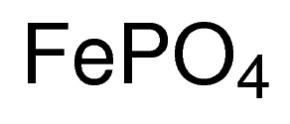Formula FePO4 | Appearance yellow-brown solid | |
 | ||
Iron(III) phosphate, also ferric phosphate, is the inorganic compound with the formula FePO4. Several related materials are known, including four polymorphs of FePO4 and two polymorphs of the dihydrate FePO4·(H2O)2. These materials find several technical applications as well as occurring in the mineral kingdom.
Contents
Structure
The most common form of FePO4 adopts the structure of α-quartz. As such the P and Fe have tetrahedral molecular geometry. At high pressures, a phase change occurs to a more dense structure with octahedral Fe centres. Two orthorhombic structures and a monoclinic phase are also known. In the two polymorphs of the dihydrate, the Fe center is octahedral with two mutually cis water ligands.
Uses
Iron(III) phosphate is one of the few molluscicides approved for use in the practice of organic farming, but unlabelled addition of EDTA contradicts such labelling.
It can be used in steel and metal manufacturing processes. When bonded to a metal surface, iron phosphate prevents further oxidation of the metal. Its presence is partially responsible for the corrosion resistance of the Iron pillar of Delhi.
Iron phosphate coatings are also primarily used as base coatings for paint in order to increase adhesion to the iron or steel substrate, and is often used in rustproofing as well. It can also be used for bonding fabrics, wood, and other materials to these surfaces as well. Iron phosphate coatings are usually applied as part of a painting or powder coating process.
Iron phosphate can also be used as an intercalation electrode in a lithium-ion battery despite having low electronic conductivity. However, in recent years its use as an electrode material has been increasingly more common as materials engineers have overcome the electronic conductivity issue. FePO4 is an ideal electrode material for batteries in electric vehicles due to its thermal stability and generally good cyclability.
Legislation
Iron(III) phosphate is not allowed as food additive in the European Union. It was withdrawn from the list of allowed substances in the directive 2002/46/EC in 2007.
Safety
In mammals, Iron phosphate can cause eye, skin, and respiratory tract irritation and may be harmful if swallowed.
Controversial Use as Organic Pesticide
Iron phosphate containing slug baits are fairly new in the garden and their danger is not yet fully researched or understood.
In the United States, unlisted addition of EDTA (ethylene-diamine-tetraacetic acid) to Iron phosphate containing products (such as Sluggo) greatly increases the toxicity.
Pellets containing iron phosphate plus chelating agents are consumed by earthworms and other invertebrates. The iron EDTA complex formed by the reaction of ferric EDTA with hydroxide ions, and the potential for EDTA to leach heavy metals from soil into groundwater, makes its use in organic gardening questionable.
A 2006 review of these products by the Swiss organic certification organisation (FiBL) discovered the EDTA content and stated products were likely to be no safer than the metaldehyde baits. According to a 2012 petition to remove ferric phosphate (III) from a list of accepted organic ingredients, it "appears that all of the ferric phosphate slug and snail baits currently marketed in the U.S. contain EDTA in their formulations.
